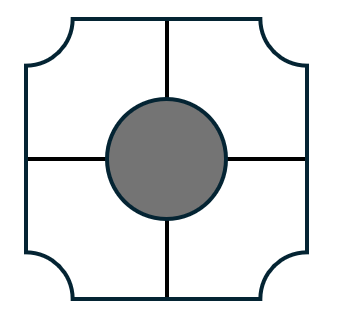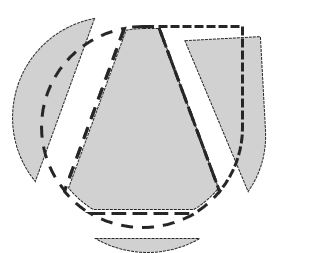Visualisation Analogy: Piece Matching and Tangram Puzzles
A graphic understanding of “Matching the Pieces and Parts” as an assessment determines the pupil’s mastery of where to place the missing pieces to complete a specific figure. This reduces the time needed to develop pattern recognition, spatial visualisation, and other skills to pass the design aptitude tests (DAT). Visualisation Analogy is relevant for DAT tests because it makes students comprehend how forms fit together. Therefore, aspiring designers must understand this since it mimics the real-life responsibilities of putting together, designing, and conceptualising design.
.png)
For establishing effective and strong visualisation analogy, it is the visual analogy-based question for matching the figures which help in the observation of the similarities and differences in the given figures. This question serves in an applied manner, where one has to remember counting on the piece and the shape of those pieces, as well as the application and approach we shall understand in this study material. We must now learn the various types of questions to be asked.
- Visualising the part for the given parent/master figure.
- Visualising the Master/Parent image from the given pieces.
Let’s Understand the types of questions through the examples.

1. Visualising the part for the given parent/master figure.
Here, a parent/master figure is given on the hand side and is split into four or more pieces, and the aspirant has to identify the correct combination of pieces that could come together to make this master figure.
For simplicity of understanding, the image is broken down into four pieces, as shown below for your reference, which could combine to make the main figure.

2. Visualising the Master/Parent image from the given pieces.
The question may be asked interchangeably by providing the pieces of a figure, and the aspirant/student may be asked to guess the correct figure from the combination of the given pieces.
# Note: Sometimes, an additional piece is provided, as shown in the intermediate step, to test the visual memory of the aspirant. Here, the red piece(Distractor) is an extra piece to disguise the viewer.

Step-by-Step Approach to Attempt the Piece Matching Puzzles
Step 1: Take note of the Master Figure.
Identify the critical details like the number of sides and angles in the given
the figure, the symmetry(if any), and distinct lines in the figure.
Step 2: Examine Every Choice in Answers
Examine each choice that is listed on the right. Examine the differences
between the master figure and the shapes, sides, and angles.
Step 3: Alignment with the Direction
If possible, verify which options need to be flipped or rotated so they line up
with certain portions of the master figure.
Step 4: Testing to Fit
Put each choice in your Visualization from the master figure. Suppose each component would fit into the master figure as follows ask for the following questions :
4a. Does the piece given fit into alignment with the master figure?
4b. Does it fit the existing lines and edges perfectly?
4c. Remove the choices that don't fit or have odd angles or sides.
Step 5: Discard Wrong Choices
Reject the options that seem unfit to the question based on your observations.
Pay attention to those that appear to match the dimensions.
Step 6: Match the Correct Option
After removing all of the wrong options, cross-check the revealed option that
It completely suits the master figure to the best of my abilities.
Let’s understand the approach through an example:

Q: Looking at the pieces on the right, identify the option that does not qualify to
be part of a combination forming the parent figure on the left.
Step 01: Understand the master figure.

Step 02: Examine all the given options in the answer choices as given
Also, count the number of pieces possible, i.e. four, whereas in
In the answer options, there are five figures.
Step 03: Mentally visualise and try to align the pieces to fit together and identifying

The additional piece that is provided and not fitting the arrangement
Step 04: Test fit the possible options to combine and make the parent figure as given
in the question.
Trick: “Quickly Try to Doodle for finding the right option.”
Step 05: As per the possible combination of the options, option E. does not qualify
to be part of the arrangement.
You can refer to the below articles:
Fundamental Geometry Concepts for 2D Shapes
Color Theory, Color Wheel for Designers
Mirror and Water Images for Design Entrances Exams
Introduction to Tangram Puzzles
Tangram puzzles are traditional Chinese geometric puzzles from the 960s–1279s AD Song Dynasty. The Tangram, sometimes called the "Seven Boards of skill," is a puzzle that originates in China.
It comprises seven flat pieces, or tans: five triangles, one square and one parallelogram. The primary purpose is to swap the tans to make the figure as dreamed of desired shape or posture and without any tile overlap.
Understanding Tangram Puzzle Strategies is essential for DAT because they evaluate the person’s basic design skills, such as geometry, spatial recognition, and critical thinking. Tangrams resemble actual jobs in design where building and visualising shapes form an integral part of the working process, which demands the ability to discern how particular shapes interconnect to constitute a figure.
Sample Question (Previous Year)
Q: A square is cut into seven pieces, as shown on the extreme left of the image. Identify which of the options can be made using all seven pieces.

Frequently Asked Questions (FAQs)
In DAT tests, "Matching the Pieces and Parts" exercises are essential because they test three critical skills for aspiring designers: spatial reasoning, pattern recognition, and attention to detail. Candidates gain the capacity to conceptualise and assemble designs by learning how elements fit together, which is similar to design work in the real world. This ability is crucial for a design career, so design aptitude assessments include it heavily.
A master figure that has been divided into many pieces is provided for this assignment. Finding the right pieces to put the master figure back together is the candidate's job. This procedure assesses a candidate's shape, angle, and symmetry recognition capacity. It strengthens their visual memory and spatial reasoning—essential skills for performing well on design aptitude tests like the DAT.
Observe the master figure's sides, angles, and symmetry to begin answering these questions correctly. Examine each choice, mentally fitting it into the main figure while taking into account any necessary flips or rotations. Toggle between the alternatives that match the missing components and those that are blatantly inaccurate. This methodical technique increases accuracy and is essential for answering these questions in DAT testing.
Also Read
22 Dec'24 11:13 PM
